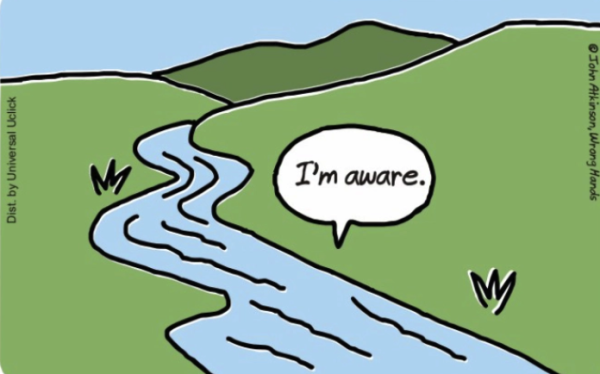Contemporary modern art: Am I missing something?
While strolling down the streets of the bustling ski town of Aspen, Colorado, one piece of architecture catches the eye of all who pass it. The Aspen Art Museum has been widely criticized for its picnic-basket-meets-cubism exterior style and for its obnoxious interruption of the quaint Victorian architecture of the rest of the city. More condemned, however, seems to be the ever-changing “exhibits” within the actual museum: of tarps hanging on walls, piles of sand and rocks, and even, once, an entire room devoted to a mountain of rubble. I remember having stood for five minutes, laughing uncontrollably, as I watched a museum curator hand out oranges that had been piled into a pyramid. Yet, more than four years later, my brother learned about the very same pyramid of oranges in an art class, if you can believe it. Thus, modern art seems to continuously beg the question: what counts as art?
Unfortunately, no real answer has been achieved, other than its goal is to provoke emotion. If laughter constitutes emotion, then was I in the right for laughing after all? Or was I in the wrong because I hadn’t given the art a chance to change my mind? Was the artist himself laughing at the fact that they put his pile of oranges in a museum? Or was there meaning, too profound for me to grasp, just behind it?
I often think to myself how the very first abstract artist came up with the idea to, well, be abstract. Imagine a world with no other art besides classical, realistic portraiture and landscape, the only “abstract” art lying in sand carved by children’s fingers or ancient caves yet to be discovered. But abstract art is more than just primitive or juvenile, it’s swimming across the river of human development and achievement, and looking back at the past from the other side. Abstract-ness challenges the brain; it’s inspired by rejecting centuries of art that was just too literal. Take the words of Wassily Kandinsky, often credited as the father of abstract art: “Every work of art is the child of its age and, in many cases, the mother of our emotions.” So, in a sense, every piece of art that is created is participating in the advancement of society; it acts as a landmark of understanding our complex emotions, of our more complex histories. For us in the future, it’s easy to look at Kandinsky’s art, surrounded by a frame of immortal prestige, and think, sure, yeah, his abstract art definitely contributed to society. But Kandinsky, what about all the “abstract” art now? Where do we draw the line; when our eyes are too sore, when museums are too full of hanging spoons and wax molds of dismembered limbs? For many, the idea that artwork must “challenge” the brain has been taken too far, and reverted back to the primitive stage that art—a passion devoted to progress—has feared.
Critics of contemporary modern art often recycle the same defense: artwork that seemingly takes little talent is being sold for millions of dollars, and I could paint that, so do I get money too? The art of Kazimir Malevich, a pioneer of abstract art in the 20th century, often comes under fire during discussions like these. His most controversial works generally tend to consist of, quite simply, a monochrome square on a white background. That’s it. His famous piece “White on White,” which is featured in the New York Museum of Modern Art, is… well, you can guess. So why is it in the MoMA? Well, maybe it’s because Malevich was the first of his kind. He pioneered this idea and called it “Suprematism,” a progression of cubism that focused more on basic geometric forms. Maybe it’s because he was banned from making art in this style during the adolescence of the Soviet Union, at a time when Stalin himself considered abstract art “bourgeois art,” and essentially banned it in place of Socialist Realism, or artistic propaganda. Maybe it’s because, in his perspective, it was more than just squares he was painting, it was, as Malevich himself puts it, “the creation of intuitive reason. The square is a living, regal infant. The first step of pure creation in art.” Hence, Malevich proves once again that art consists of progress: nuance, reflection, juxtaposition, resistance, intuition, all combined into a single white square on a white background. Art grows and changes as the interpretations of it change.
But even if you didn’t know the history of Malevich, of Kandinsky, of the pyramid of oranges, is there a right way to interpret art? By bringing in quotes from the artists themselves and telling you, essentially, what they wanted you to interpret, I seem to contradict my answer, which is no. To know the story and work behind the art may give you a greater appreciation for it, and it may make you stop saying, “I could make that!” every time you walk into a new exhibit, but it won’t stop you laughing at a pile of oranges. Meaning: interpret art in the way that gives you the greatest pleasure, the greatest understanding. It may not sound very profound, but in a way, it’s the advice of the artists themselves. Wassily Kandinsky also famously said, “There is no must in art, because art is free.” Nobody “must” see beyond a certain viewpoint, or question if they are interpreting the piece correctly, just as no artist “must” put meaning behind each painting, or, in turn, make a painting so profound the meaning explodes out of the borders. This is the beauty of modern contemporary artworks, ugly as some may seem: your own interpretation becomes enough insight. You appreciate the art because you found meaning, you expressed an emotion, you laughed. In the exhibit room next to the pyramid of oranges was a room devoted to strings of lightbulbs haphazardly strewn along the walls and ceiling. And in the middle of the floor, legs crossed with her hands on her heart, was a woman meditating. Meditating! In front of the lightbulbs on strings!
Needless to say, I have never run faster out of a room in my life, in order to release my laughter. In retrospect, and with newly gathered opinions on art interpretation, I have a newfound appreciation for the woman’s experience. It must have been a beautiful feeling to have art affect your soul that profoundly, as silly as it may look to an outsider. So, the next time you stumble upon something that you may call “hideous” or “untalented” at your local museum, react, of course! (maybe internally) But give it a chance, too. Sit with it, meditate, whatever you want, and you may find an unexpected appreciation lying within.


